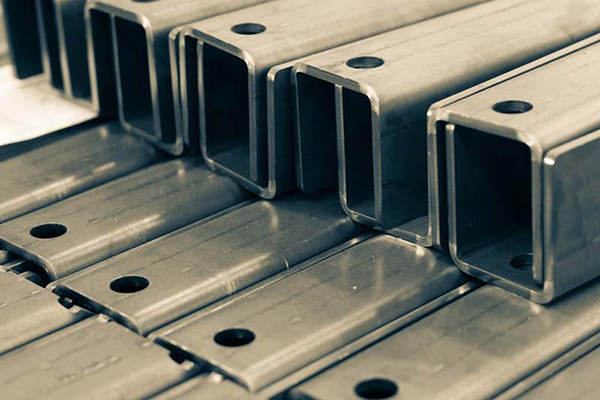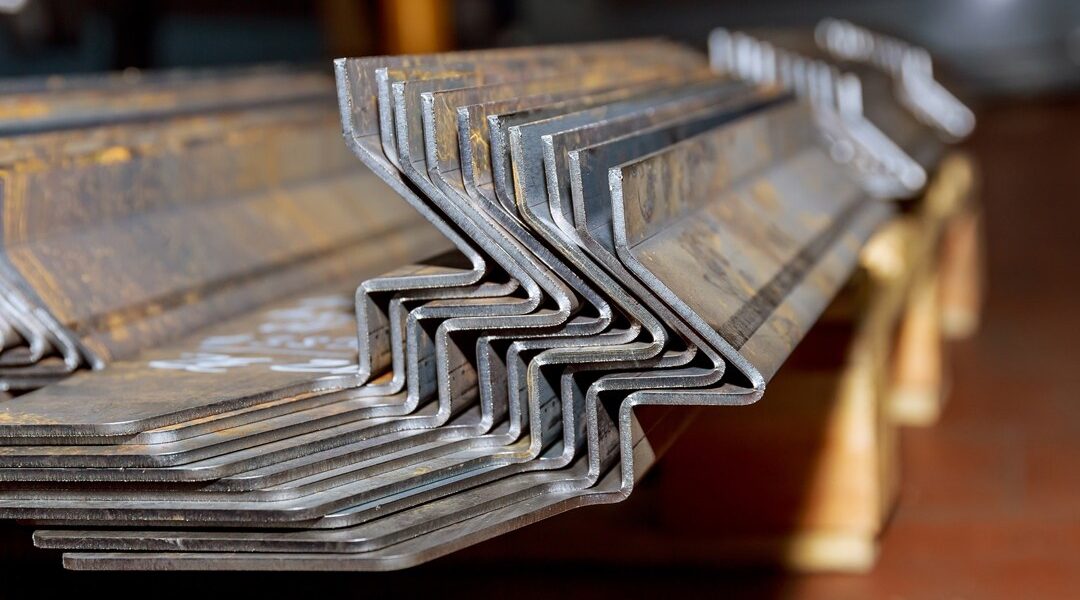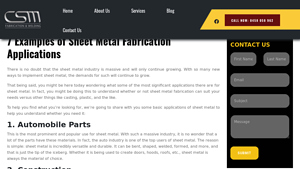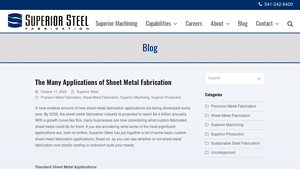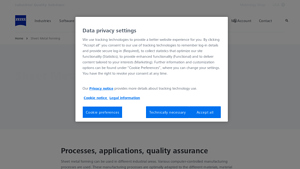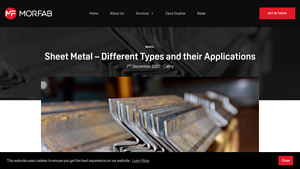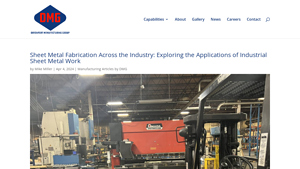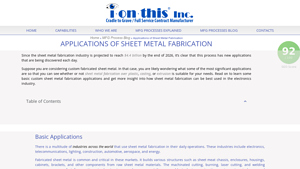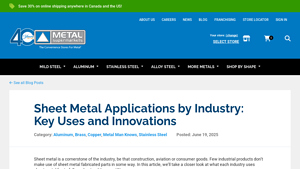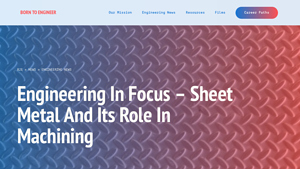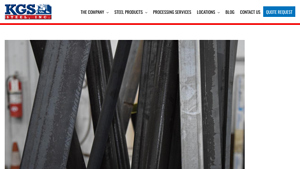Sheet Metal Applications Guide: Type, Cost, Top List…
Introduction: Navigating the Global Market for sheet metal applications
In the fast-evolving landscape of global manufacturing, sourcing the right materials for sheet metal applications presents a significant challenge for international B2B buyers. With industries spanning aerospace, automotive, electronics, and construction increasingly relying on precision-engineered sheet metal components, understanding the nuances of material selection, fabrication techniques, and supplier capabilities becomes paramount. This comprehensive guide delves into the intricacies of sheet metal applications, covering essential topics such as types of materials, fabrication methods, key applications across various sectors, and strategic supplier vetting processes.
For B2B buyers from regions like Africa, South America, the Middle East, and Europe—including emerging markets such as Saudi Arabia and Brazil—making informed purchasing decisions can drastically impact project success and profitability. This guide equips you with actionable insights into cost considerations, quality assurance practices, and the latest advancements in sheet metal technology, empowering you to navigate the complexities of sourcing and procurement effectively. By leveraging the knowledge contained herein, you can confidently select the right partners and materials, ensuring that your sheet metal applications not only meet industry standards but also drive innovation and efficiency within your operations.
Understanding sheet metal applications Types and Variations
| Type Name | Key Distinguishing Features | Primary B2B Applications | Brief Pros & Cons for Buyers |
|---|---|---|---|
| Aerospace Components | Lightweight, high-strength materials; precision-engineered | Aircraft structures, engine components, satellite housings | Pros: High durability, essential for safety; Cons: Higher costs due to material and precision requirements. |
| Automotive Parts | Sturdy, corrosion-resistant; often involves complex geometries | Chassis, body panels, brackets, and exhaust systems | Pros: Lightweight and strong; Cons: Requires precise manufacturing to meet industry standards. |
| Electronics Enclosures | Customizable designs; often uses aluminum for thermal management | Housing for computers, telecom equipment, and consumer electronics | Pros: Quick prototyping and manufacturing; Cons: May require additional coatings for durability. |
| HVAC Systems | Robust, often insulated; designed for airflow efficiency | Ductwork, air conditioning units, and heat exchangers | Pros: Essential for energy efficiency; Cons: Installation complexity can increase overall costs. |
| Medical Devices | Biocompatible materials; precision fabrication | Surgical tools, diagnostic equipment, and imaging devices | Pros: Critical for patient safety and reliability; Cons: Regulatory compliance can complicate production. |
What Are the Key Characteristics of Aerospace Components in Sheet Metal Applications?
Aerospace components are characterized by their lightweight yet high-strength materials, often made from aluminum or titanium alloys. These components must meet stringent safety and performance standards, making precision engineering essential. B2B buyers in this sector should prioritize suppliers with a proven track record in aerospace fabrication and certifications, such as AS9100, to ensure compliance with industry regulations.
How Do Automotive Parts Utilize Sheet Metal Fabrication?
Automotive parts leverage sheet metal fabrication for their strength and corrosion resistance, essential for vehicle durability and safety. Common applications include chassis, body panels, and brackets. Buyers should consider the supplier’s ability to produce complex geometries and their experience with automotive standards, such as ISO/TS 16949, to ensure quality and reliability.
Why Are Electronics Enclosures Important in Sheet Metal Applications?
Electronics enclosures are vital for protecting sensitive components from environmental factors. Typically fabricated from aluminum for its lightweight and thermal management properties, these enclosures can be customized to fit various designs. B2B purchasers should focus on manufacturers that offer rapid prototyping and flexible production capabilities to meet fast-paced market demands.
What Role Does Sheet Metal Play in HVAC Systems?
Sheet metal is crucial in HVAC systems, where it is used to create robust ductwork and air conditioning units. These components must be designed for optimal airflow efficiency and often require insulation. Buyers should evaluate suppliers based on their ability to provide energy-efficient solutions and their experience with HVAC standards, as installation complexity can influence overall costs.
How Are Medical Devices Fabricated from Sheet Metal?
Medical devices often utilize sheet metal for components that require precision and biocompatibility. Surgical tools and diagnostic equipment are common applications, where reliability is paramount. B2B buyers must ensure that their suppliers adhere to strict regulatory standards, such as ISO 13485, to guarantee the safety and effectiveness of medical devices.
Key Industrial Applications of sheet metal applications
| Industry/Sector | Specific Application of Sheet Metal Applications | Value/Benefit for the Business | Key Sourcing Considerations for this Application |
|---|---|---|---|
| Aerospace | Aircraft Structural Components | High strength-to-weight ratio, durability | Compliance with aerospace standards, precision machining |
| Automotive | Chassis and Body Parts | Lightweight, fuel efficiency, safety | Material certification, custom fabrication capabilities |
| Electronics | Enclosures for Electronic Devices | Protection from environmental factors, aesthetics | Design flexibility, rapid prototyping options |
| Renewable Energy | Wind Turbine Components | Corrosion resistance, energy efficiency | Material sourcing, adherence to environmental standards |
| Construction | HVAC Ductwork and Frames | Cost-effective, energy-efficient solutions | Custom sizes, insulation options, delivery timelines |
How is Sheet Metal Used in Aerospace Applications?
In the aerospace sector, sheet metal is primarily utilized for manufacturing structural components, such as fuselages and wings. These components must meet stringent safety and performance standards while maintaining a lightweight profile to enhance fuel efficiency. Buyers from regions like Europe and the Middle East should prioritize suppliers with certifications in aerospace manufacturing and a proven track record of precision machining. Additionally, the ability to customize parts to fit specific aircraft designs can significantly impact operational performance.
What Role Does Sheet Metal Play in the Automotive Industry?
In automotive manufacturing, sheet metal is essential for creating chassis and body parts. The lightweight nature of materials like aluminum and high-strength steel contributes to overall vehicle efficiency and safety. For international buyers, particularly in Brazil and South Africa, sourcing sheet metal components requires attention to material certifications and compliance with local safety regulations. Companies should also look for manufacturers that offer tailored solutions to meet specific design and performance requirements.
How is Sheet Metal Utilized in Electronics?
The electronics industry heavily relies on sheet metal for creating enclosures and housings for devices such as computers and telecommunications equipment. These enclosures protect sensitive components from environmental damage while allowing for effective heat dissipation. Buyers should seek manufacturers that provide rapid prototyping services, as this can expedite time-to-market for new products. Additionally, flexibility in design and the ability to work with various metals, such as aluminum, are critical for meeting the diverse needs of this sector.
What are the Benefits of Sheet Metal in Renewable Energy?
In the renewable energy sector, particularly wind energy, sheet metal is used to fabricate components like turbine blades and housings. The materials used must be resistant to corrosion and capable of withstanding harsh environmental conditions. For B2B buyers in regions like Africa and the Middle East, it is essential to source from suppliers who understand the unique challenges of renewable energy applications and can provide durable solutions. Ensuring that materials adhere to sustainability standards can also enhance the overall value proposition.
How is Sheet Metal Applied in Construction?
In construction, sheet metal is widely used for HVAC ductwork and structural frames. Its cost-effectiveness and energy-efficient properties make it a preferred choice for many builders. Buyers should consider sourcing from manufacturers that can provide custom sizes and insulation options to meet specific project requirements. Additionally, timely delivery and the ability to handle large orders are crucial for keeping construction projects on schedule, particularly in fast-growing markets in South America and Africa.
3 Common User Pain Points for ‘sheet metal applications’ & Their Solutions
Scenario 1: Inconsistent Quality Across Suppliers
The Problem: B2B buyers often face significant challenges when sourcing sheet metal components from multiple suppliers. Variability in quality can lead to production delays, increased costs, and even compromised safety in the final products. For instance, a manufacturer in Brazil may source aluminum panels from different suppliers, only to discover that the thickness and finish vary significantly. Such discrepancies can result in mismatched components, necessitating costly rework or even scrapping entire batches.
The Solution: To mitigate quality inconsistencies, buyers should implement a robust supplier evaluation process. This involves conducting thorough audits of potential suppliers, focusing on their manufacturing capabilities, certifications (like ISO), and quality assurance processes. Furthermore, establishing clear specifications and standards for the sheet metal products is crucial. This includes detailing material grades, tolerances, and surface finishes in purchase orders. Regular communication and collaboration with suppliers can also help ensure that they understand and meet these standards consistently. Utilizing technology such as ERP systems can streamline this process by providing real-time tracking and quality control data.
Scenario 2: Difficulty in Customization and Prototyping
The Problem: Many B2B buyers encounter difficulties when they need customized sheet metal components, especially during the prototyping phase. For example, a company in Saudi Arabia developing a new electronic enclosure may struggle to find a supplier that can quickly adapt designs based on evolving specifications. Traditional methods may take too long, causing delays in the overall project timeline and preventing the product from reaching the market swiftly.
The Solution: To overcome these challenges, buyers should seek out suppliers who specialize in rapid prototyping and have advanced capabilities like CNC machining, laser cutting, and 3D printing for sheet metal. These technologies allow for faster iterations and more precise customizations. When engaging with potential suppliers, it’s beneficial to provide them with detailed CAD drawings and a clear outline of the project timeline. Establishing a collaborative relationship can also facilitate quicker adjustments to designs. Moreover, using prototyping services that offer instant quoting and short lead times will ensure that development stays on track.
Scenario 3: High Costs of Production and Material Waste
The Problem: Cost management is a critical concern for B2B buyers, particularly when dealing with sheet metal applications. Inefficient production processes or excessive material waste can lead to inflated costs. For instance, a manufacturing plant in South Africa may find that their cutting techniques produce significant scrap metal, driving up expenses and reducing profit margins.
The Solution: To reduce production costs and material waste, buyers should invest in advanced manufacturing techniques like laser cutting and CNC plasma cutting, which optimize material usage. These technologies allow for intricate designs and precise cuts that minimize scrap. Additionally, conducting a thorough analysis of the production process can identify inefficiencies. Implementing lean manufacturing principles can streamline operations, reduce waste, and lower costs. Buyers should also consider sourcing materials in bulk and negotiating long-term contracts with suppliers for better pricing. Regularly reviewing production metrics will help in identifying areas for improvement and ensuring that cost-saving measures are effective.
Strategic Material Selection Guide for sheet metal applications
What Are the Key Properties of Common Sheet Metal Materials?
When selecting materials for sheet metal applications, it is crucial to understand the properties that affect product performance. Here, we analyze four common materials: Aluminum, Stainless Steel, Cold Rolled Steel, and Copper. Each material has unique characteristics that influence its suitability for various applications, particularly for international B2B buyers.
How Does Aluminum Perform in Sheet Metal Applications?
Aluminum is renowned for its excellent corrosion resistance, lightweight nature, and good thermal and electrical conductivity. These properties make it ideal for applications where weight is a critical factor, such as in the aerospace and automotive industries. However, while aluminum is easy to machine and fabricate, it can be more expensive than other metals, which may deter cost-sensitive projects. Additionally, its lower tensile strength compared to steel may limit its use in high-stress applications.
For international buyers, particularly in regions like Africa and South America, compliance with local standards (e.g., ASTM) is essential. Aluminum’s recyclability also aligns with sustainability goals prevalent in European markets, making it a preferred choice in environmentally conscious projects.
What Are the Advantages and Disadvantages of Stainless Steel?
Stainless steel is celebrated for its exceptional strength, durability, and corrosion resistance, making it suitable for harsh environments, including chemical processing and food production. Its hygienic properties are essential in applications requiring cleanliness, such as medical devices and food processing equipment. However, the material can be more challenging to work with due to its hardness, leading to higher manufacturing costs and complexities.
For B2B buyers in the Middle East and Europe, it’s vital to consider the specific grades of stainless steel (e.g., 304, 316) that comply with local standards. The choice of grade can significantly impact performance and compliance with regulations, particularly in industries like food and pharmaceuticals.
How Does Cold Rolled Steel Compare?
Cold Rolled Steel (CRS) is favored for its strength and surface finish, making it suitable for applications requiring precision and durability, such as automotive parts and structural components. CRS is generally less expensive than aluminum and stainless steel, providing a cost-effective solution for many projects. However, its corrosion resistance is lower, necessitating protective coatings in environments prone to moisture.
International buyers should be aware of the need for protective measures in humid climates, such as those found in parts of Africa and South America. Adhering to standards like ASTM can ensure that the chosen CRS meets necessary performance criteria for specific applications.
What Is the Role of Copper in Sheet Metal Applications?
Copper is known for its outstanding electrical conductivity and ductility, making it a prime choice for electrical applications, such as wiring and electronic components. Its resistance to corrosion further enhances its longevity in various environments. However, the high cost of copper can be a limiting factor for large-scale applications, and its softness may not suit all structural needs.
For international buyers, especially in the electronics sector, understanding the implications of using copper in terms of compliance with electrical standards (e.g., IEC) is crucial. The material’s recyclability also aligns with sustainability initiatives, a growing concern in many global markets.
Summary Table of Material Properties
| Material | Typical Use Case for sheet metal applications | Key Advantage | Key Disadvantage/Limitation | Relative Cost (Low/Med/High) |
|---|---|---|---|---|
| Aluminum | Aerospace components, automotive parts | Lightweight and excellent corrosion resistance | Lower tensile strength than steel | Medium |
| Stainless Steel | Food processing equipment, medical devices | Exceptional strength and corrosion resistance | Higher manufacturing complexity | High |
| Cold Rolled Steel | Automotive parts, structural components | Cost-effective and strong | Lower corrosion resistance requiring coatings | Low |
| Copper | Electrical wiring, electronic components | Outstanding electrical conductivity | High cost and softness may limit applications | High |
This strategic material selection guide provides valuable insights for B2B buyers navigating the complexities of sheet metal applications across diverse industries and regions. Understanding the properties, advantages, and limitations of each material can significantly influence project outcomes and compliance with international standards.
In-depth Look: Manufacturing Processes and Quality Assurance for sheet metal applications
What Are the Main Stages of Manufacturing for Sheet Metal Applications?
The manufacturing process for sheet metal applications is complex and involves several key stages: material preparation, forming, assembly, and finishing. Each stage is critical for producing high-quality components that meet the diverse needs of various industries.
How is Material Prepared for Sheet Metal Fabrication?
Material preparation begins with the selection of appropriate sheet metal, which can include materials such as aluminum, stainless steel, or copper, each chosen based on the specific application requirements. The selected sheets are then cut to size using techniques like laser cutting or plasma cutting. These methods ensure precision and can accommodate various thicknesses, which is vital for achieving the desired specifications.
Once cut, the material undergoes surface treatment to remove any contaminants, such as oils or rust, that may affect the subsequent processes. This step is crucial for ensuring that the metal adheres well during forming and finishing.
What Forming Techniques Are Commonly Used in Sheet Metal Manufacturing?
The forming stage involves shaping the prepared metal sheets into the desired configurations. Common techniques include:
-
Bending: Utilizing press brakes or automated bending machines, metal sheets are bent into specified angles. This process is essential for creating components like brackets or enclosures.
-
Punching: CNC punching machines create holes or shapes in the metal, allowing for further assembly and functionality. This technique is particularly useful for creating intricate designs or patterns.
-
Welding and Riveting: These methods are employed to join multiple pieces of metal together. Welding provides a strong, permanent bond, while riveting allows for assembly without the need for heat, making it suitable for certain applications.
Each of these techniques requires skilled operators and precise machinery to ensure accuracy and repeatability, which are vital for maintaining quality standards.
How is Assembly Done in Sheet Metal Fabrication?
After the forming processes, the individual components are assembled into final products. This may involve welding, riveting, or using adhesives to join parts securely. During this stage, it’s essential to ensure that all components fit together correctly and that any necessary adjustments are made.
Quality assurance is paramount during assembly, as misaligned components can lead to product failures. Thus, many manufacturers employ fixtures and jigs to ensure precise assembly and to facilitate the repeatability of the process.
What Finishing Processes Are Important for Sheet Metal Products?
Finishing processes enhance the aesthetic and functional properties of sheet metal products. Common finishing techniques include:
-
Coating: Applying protective coatings, such as powder coating or galvanization, helps prevent corrosion and enhances durability. This is particularly important for products exposed to harsh environments.
-
Polishing: For aesthetic purposes, components may be polished to achieve a smooth, reflective surface. This is often required in consumer-facing products, such as appliances or decorative items.
-
Quality Control Inspection: After finishing, products undergo rigorous quality checks to ensure they meet the required specifications and standards.
What Quality Assurance Standards Are Relevant for Sheet Metal Manufacturing?
Quality assurance in sheet metal fabrication is critical, especially for international B2B buyers. Adhering to established quality standards not only ensures product reliability but also builds trust between manufacturers and clients.
Which International Standards Should Buyers Look For?
The most recognized international standard for quality management systems is ISO 9001. This standard outlines criteria for an effective quality management system, ensuring that organizations consistently provide products that meet customer and regulatory requirements.
In addition to ISO 9001, industry-specific certifications such as CE marking for products sold in the European Economic Area and API standards for the oil and gas industry may also be relevant. These certifications demonstrate compliance with safety, health, and environmental protection standards.
What Are the Key Quality Control Checkpoints in Sheet Metal Manufacturing?
Quality control (QC) involves several checkpoints throughout the manufacturing process to ensure that products meet the established standards. The main QC checkpoints include:
-
Incoming Quality Control (IQC): This stage involves inspecting raw materials upon arrival to ensure they meet specified standards before processing begins.
-
In-Process Quality Control (IPQC): During manufacturing, regular inspections are conducted to monitor the production process and detect any deviations from quality standards.
-
Final Quality Control (FQC): After assembly and finishing, the final product is thoroughly inspected to confirm that it meets all specifications and quality requirements before shipping.
How Can B2B Buyers Verify Supplier Quality Control Processes?
For B2B buyers, especially those from Africa, South America, the Middle East, and Europe, verifying a supplier’s quality control processes is essential for ensuring product reliability.
What Methods Can Be Used to Assess Supplier Quality?
-
Supplier Audits: Conducting audits of potential suppliers allows buyers to assess their quality management systems and manufacturing processes firsthand. This can reveal a lot about their commitment to quality.
-
Requesting Quality Reports: Buyers should request documentation that outlines the supplier’s quality control procedures, including any certifications or audit reports.
-
Third-Party Inspections: Engaging independent third-party inspectors to assess the manufacturing process can provide an unbiased evaluation of the supplier’s quality assurance practices.
What Are the Quality Control Nuances for International B2B Buyers?
International B2B buyers should be aware of specific nuances when it comes to quality control. Different regions may have varying standards and regulations, which can affect product compliance. Additionally, language barriers and cultural differences may impact communication regarding quality expectations.
It’s crucial for buyers to establish clear communication channels with suppliers and to ensure that both parties understand the quality standards required for successful transactions. This proactive approach can help mitigate risks associated with international procurement and ensure that the final products meet the buyers’ expectations.
In summary, understanding the manufacturing processes and quality assurance protocols for sheet metal applications empowers B2B buyers to make informed decisions, ensuring that they source high-quality products that meet their specific needs.
Practical Sourcing Guide: A Step-by-Step Checklist for ‘sheet metal applications’
When procuring sheet metal applications, an organized approach is vital to ensure that your project meets specifications, budget, and quality standards. This guide provides a step-by-step checklist for B2B buyers aiming to navigate the complexities of sourcing sheet metal products effectively.
Step 1: Define Your Technical Specifications
Begin by clearly outlining the technical requirements for your sheet metal applications. This includes dimensions, material types, thickness, and any specific mechanical properties needed for your project. A well-defined specification not only helps in communicating your needs to suppliers but also assists in obtaining accurate quotes and reducing the risk of costly errors.
Step 2: Research Potential Suppliers
Conduct thorough research to identify suppliers that specialize in the specific types of sheet metal applications you require. Look for companies with a proven track record in your industry and those that utilize modern fabrication techniques such as laser cutting, CNC machining, or welding. Utilize online directories, industry forums, and trade shows to compile a list of potential suppliers.
Step 3: Evaluate Supplier Capabilities
Before committing, assess each supplier’s capabilities. Inquire about their manufacturing processes, technology, and quality control measures. Ensure they have the necessary equipment and expertise to meet your specific requirements. Additionally, ask for examples of past projects to gauge their experience with similar applications.
Step 4: Verify Supplier Certifications
It’s essential to verify that potential suppliers hold relevant certifications that demonstrate their compliance with industry standards. Look for ISO certifications, quality management systems, and adherence to safety regulations. Certifications indicate a commitment to quality and reliability, which can significantly impact your project’s success.
Step 5: Request Detailed Quotes
Once you have narrowed down your supplier options, request detailed quotes that outline costs, lead times, and payment terms. Ensure that the quotes reflect your specifications and include any additional services such as finishing, packaging, and shipping. Comparing these quotes will help you make an informed decision based on value rather than just price.
Step 6: Assess Communication and Support
Effective communication is crucial in any B2B relationship. Evaluate how responsive and supportive potential suppliers are during the inquiry process. A supplier that prioritizes clear communication and is willing to provide ongoing support can make the procurement process smoother and more efficient.
Step 7: Conduct a Pilot Order
Before finalizing a long-term partnership, consider placing a pilot order to assess the supplier’s performance. This initial order allows you to evaluate the quality of the products, adherence to timelines, and overall service. Use this opportunity to address any issues before scaling up your orders.
By following these steps, B2B buyers can navigate the complexities of sourcing sheet metal applications with confidence, ensuring that they select the right suppliers to meet their project needs efficiently and effectively.
Comprehensive Cost and Pricing Analysis for sheet metal applications Sourcing
What Are the Key Cost Components in Sheet Metal Applications Sourcing?
Understanding the cost structure of sheet metal applications is crucial for B2B buyers. The primary components include materials, labor, manufacturing overhead, tooling, quality control (QC), logistics, and profit margin.
-
Materials: The choice of metal significantly impacts pricing. Common materials such as aluminum and stainless steel have varying costs based on market demand, availability, and global supply chain dynamics. For instance, while aluminum is lightweight and corrosion-resistant, stainless steel offers durability and strength, often at a higher price point.
-
Labor: Skilled labor is essential in sheet metal fabrication. Labor costs can vary based on region, expertise required, and production complexity. Automation in manufacturing processes can mitigate labor costs but may require a significant initial investment in technology.
-
Manufacturing Overhead: This includes expenses related to facility maintenance, utilities, and equipment depreciation. High overhead costs can lead to increased prices for end products.
-
Tooling: Tooling costs are incurred for the creation of custom molds or dies. These costs are generally amortized over the production run, meaning larger orders can significantly reduce the per-unit tooling cost.
-
Quality Control: Ensuring that products meet international standards and certifications often involves additional costs. Investing in QC processes can prevent costly reworks and enhance product reliability.
-
Logistics: Transporting materials and finished goods adds to the overall cost. International shipping, tariffs, and customs duties can be particularly impactful for buyers in regions such as Africa, South America, and the Middle East.
-
Margin: Suppliers will add a profit margin to cover their operational costs and risks. Understanding typical margins in your specific market can aid in negotiation.
How Do Price Influencers Affect Sheet Metal Application Costs?
Several factors influence the pricing of sheet metal applications:
-
Volume and Minimum Order Quantity (MOQ): Larger orders typically lead to cost savings due to economies of scale. Suppliers often have a MOQ, which can affect pricing structure significantly.
-
Specifications and Customization: Custom designs or specific tolerances can increase production time and complexity, driving up costs. Standardized designs are generally more cost-effective.
-
Material Choices: The type and quality of materials chosen can greatly affect pricing. Premium materials with special coatings or finishes will lead to higher costs.
-
Quality and Certifications: Products that require compliance with specific industry standards or certifications will incur additional costs. Buyers should assess whether these certifications are necessary for their applications.
-
Supplier Factors: The supplier’s location, reliability, and production capabilities can influence pricing. Establishing long-term relationships with reliable suppliers can yield better pricing and terms.
-
Incoterms: Understanding international shipping terms is crucial, as they define responsibilities for shipping, insurance, and tariffs. Properly negotiated Incoterms can lead to significant savings.
What Are Some Effective Buyer Tips for Negotiating Sheet Metal Prices?
For B2B buyers, particularly those in diverse markets, here are strategies to enhance cost efficiency:
-
Negotiate Volume Discounts: Always inquire about discounts for larger orders. Suppliers are often willing to negotiate prices for bulk orders, which can significantly reduce per-unit costs.
-
Evaluate Total Cost of Ownership: Consider not just the initial purchase price but also the long-term costs associated with maintenance, durability, and potential rework. A lower upfront cost might result in higher long-term expenses if the product does not meet quality standards.
-
Understand Pricing Nuances for International Sourcing: Be aware of currency fluctuations, tariffs, and local regulations that may affect pricing. Engaging with local suppliers or those familiar with your market can reduce risks.
-
Build Long-Term Relationships: Establishing a strong rapport with suppliers can lead to better pricing and terms over time. Suppliers are often more willing to accommodate loyal customers.
-
Stay Informed on Market Trends: Keeping up with industry trends can provide insights into material costs and potential price changes. This knowledge can aid in timing purchases to achieve the best prices.
Conclusion
While the pricing landscape for sheet metal applications can be complex, understanding the cost components, price influencers, and effective negotiation strategies can empower B2B buyers to make informed purchasing decisions. Always remember that prices can vary widely based on multiple factors, so conducting thorough market research and engaging with multiple suppliers is essential for achieving the best value.
Alternatives Analysis: Comparing sheet metal applications With Other Solutions
In the world of manufacturing and fabrication, businesses often face the challenge of selecting the most suitable material or method for their projects. While sheet metal applications have proven to be versatile and reliable, several alternative solutions can also fulfill similar requirements. This section explores the comparison between sheet metal applications and other viable methods, helping B2B buyers make informed decisions.
Comparison Table of Alternatives
| Comparison Aspect | Sheet Metal Applications | Thermoplastic Injection Molding | 3D Printing |
|---|---|---|---|
| Performance | High strength, durability, and precision | Good for complex shapes, but less durable | Versatile, good for rapid prototyping |
| Cost | Moderate, especially for large runs | High initial setup costs, but economical for large volumes | Cost-effective for small batches but can be expensive per unit |
| Ease of Implementation | Requires specialized machinery and skilled labor | Complex setup but streamlined for mass production | Relatively easy setup with less specialized equipment |
| Maintenance | Low maintenance, but requires skilled operators | Low once set up; molds require maintenance | Minimal maintenance, but printer calibration is essential |
| Best Use Case | Aerospace, automotive, electronics | High-volume production of detailed parts | Prototyping and custom parts in small quantities |
Detailed Breakdown of Alternatives
Thermoplastic Injection Molding
This method involves injecting molten plastic into a mold to create complex shapes. It excels in producing high volumes of consistent parts. However, the initial costs for molds can be substantial, making it less suitable for low-volume production. While thermoplastics can achieve intricate designs, they generally lack the strength and durability of metal parts. Industries like consumer goods and medical devices often utilize this method for mass production.
3D Printing
3D printing, or additive manufacturing, allows for the rapid creation of parts by layering materials based on digital designs. This method is particularly advantageous for producing complex geometries and custom designs without the need for extensive tooling. It is ideal for prototyping and low-volume runs, although the cost per unit can be high when scaled. While 3D printing materials may not always match the mechanical properties of sheet metal, ongoing advancements continue to improve the strength and usability of printed components.
Conclusion: How to Choose the Right Solution for Your Needs
When deciding between sheet metal applications and alternative methods, B2B buyers should consider their specific project requirements, including volume, durability, and complexity of design. Sheet metal remains a strong choice for high-strength applications in industries like aerospace and automotive, while thermoplastic injection molding and 3D printing offer unique advantages for specific scenarios. By evaluating these factors, buyers can select the most suitable solution that aligns with their operational goals and market demands.
Essential Technical Properties and Trade Terminology for sheet metal applications
What Are the Key Technical Properties of Sheet Metal Applications?
Understanding the technical properties of sheet metal is crucial for B2B buyers to make informed purchasing decisions. Here are some essential specifications that should be considered:
1. Material Grade
Material grade refers to the specific classification of metal based on its composition and mechanical properties. Common grades include stainless steel (e.g., 304, 316), aluminum (e.g., 6061, 5052), and low carbon steel (e.g., A36). Selecting the right grade affects durability, corrosion resistance, and suitability for different applications, making it vital for ensuring product longevity and performance.
2. Thickness
The thickness of sheet metal is typically measured in gauge or millimeters. Thicker sheets provide greater strength and durability, whereas thinner sheets are lighter and easier to manipulate. Understanding thickness is essential for B2B buyers, as it directly impacts production costs, material handling, and end-use applications.
3. Tolerance
Tolerance refers to the permissible limit of variation in a physical dimension. High precision in tolerances is crucial in industries such as aerospace and electronics, where even minor discrepancies can lead to product failure. Buyers should specify tolerances to ensure that parts fit together correctly and perform as intended.
4. Yield Strength
Yield strength is the amount of stress a material can withstand before it deforms permanently. It is a key property that determines how much load a sheet metal component can bear. For B2B buyers, understanding yield strength helps in selecting materials that will perform reliably under expected operational conditions, reducing the risk of failure.
5. Corrosion Resistance
Corrosion resistance is the ability of a material to withstand deterioration caused by environmental factors. Materials like stainless steel and aluminum offer excellent corrosion resistance, making them ideal for applications in harsh conditions. B2B buyers must consider this property to ensure the longevity and reliability of their products, particularly in industries such as construction and automotive.
What Are Common Trade Terms Used in Sheet Metal Applications?
Familiarizing yourself with industry terminology can streamline communication and negotiations. Here are several essential trade terms:
1. OEM (Original Equipment Manufacturer)
OEM refers to a company that produces parts or equipment that may be marketed by another manufacturer. Understanding OEM relationships is vital for B2B buyers, as they often determine sourcing strategies and product quality.
2. MOQ (Minimum Order Quantity)
MOQ is the minimum quantity of a product that a supplier is willing to sell. This term is crucial for B2B transactions as it affects inventory management and cash flow. Buyers should negotiate MOQs that align with their production needs to avoid excess stock or shortages.
3. RFQ (Request for Quotation)
An RFQ is a document that buyers send to suppliers to request pricing and terms for specific products or services. This process is essential for obtaining competitive bids and ensuring that all potential suppliers are evaluated on the same criteria.
4. Incoterms (International Commercial Terms)
Incoterms are a set of predefined international trade terms that clarify the responsibilities of buyers and sellers regarding shipping, insurance, and tariffs. Familiarity with Incoterms is vital for B2B buyers engaged in international transactions, as they help mitigate risks and misunderstandings during shipping.
5. CNC (Computer Numerical Control)
CNC refers to the automation of machine tools through computer programming. This technology is integral to sheet metal fabrication, allowing for high precision and repeatability. Buyers should understand CNC capabilities when discussing fabrication requirements to ensure that their specifications can be met efficiently.
By grasping these technical properties and trade terms, B2B buyers can make more informed decisions, ultimately leading to better product outcomes and smoother transactions in the sheet metal industry.
Navigating Market Dynamics and Sourcing Trends in the sheet metal applications Sector
What Are the Key Trends Driving the Global Sheet Metal Applications Market?
The global sheet metal applications market is experiencing significant growth, driven by technological advancements and increasing demand across various industries. Key trends include the integration of automation and robotics in manufacturing processes, which enhance efficiency and precision. As industries like aerospace, automotive, and electronics evolve, there’s a heightened need for custom-fabricated components, leading to a projected market value of approximately $4.4 billion by 2026.
Moreover, digital transformation is reshaping sourcing strategies, with B2B buyers increasingly relying on ERP systems and 3D printing technologies. These innovations not only streamline production but also reduce lead times, making it easier for businesses in Africa, South America, the Middle East, and Europe to meet specific project requirements swiftly. For international buyers, understanding regional supply chain dynamics is crucial; factors such as logistics costs, trade regulations, and local material availability can significantly impact sourcing decisions.
Additionally, sustainability is becoming a focal point, with buyers showing preference for suppliers that prioritize eco-friendly practices. This shift is prompting manufacturers to adopt greener materials and processes, reflecting a broader commitment to corporate social responsibility. As the industry continues to evolve, staying attuned to these trends will empower B2B buyers to make informed sourcing decisions that align with their operational goals.
How Is Sustainability and Ethical Sourcing Reshaping the Sheet Metal Sector?
In the context of sheet metal applications, sustainability and ethical sourcing are gaining prominence as businesses recognize the environmental impact of their operations. The production of sheet metal often involves energy-intensive processes, leading to a significant carbon footprint. Consequently, buyers are increasingly prioritizing suppliers who implement energy-efficient practices and utilize recycled materials in their offerings.
The importance of ethical supply chains cannot be overstated. Buyers are looking for manufacturers that adhere to fair labor practices and transparency, ensuring that their sourcing decisions align with their corporate values. Certifications such as ISO 14001 (Environmental Management) and LEED (Leadership in Energy and Environmental Design) are becoming critical in assessing suppliers’ commitment to sustainability.
Furthermore, the demand for “green” materials is on the rise. Buyers are exploring options like aluminum and stainless steel, which are not only durable but also recyclable. By opting for suppliers who provide environmentally friendly products, companies can enhance their brand reputation and appeal to a growing segment of eco-conscious consumers. This trend towards sustainability is not just a regulatory requirement; it’s a strategic advantage that can lead to cost savings and improved market positioning.
What Is the Historical Context of Sheet Metal Applications in B2B?
The evolution of sheet metal applications dates back to the industrial revolution when metalworking techniques began to advance significantly. Initially, traditional methods such as hammering and forging were prevalent, but the introduction of machinery in the late 19th century revolutionized the field. The development of processes like punching, bending, and welding allowed for more complex designs and faster production times.
As industries expanded throughout the 20th century, the demand for sheet metal components surged, particularly in automotive and aerospace sectors. Today, the integration of digital technologies, including CAD and CNC machining, has transformed sheet metal fabrication, making it more precise and efficient. This historical context illustrates how far the industry has come and highlights the continuous innovation that shapes the current landscape, providing valuable insights for B2B buyers looking to navigate today’s market dynamics.
Frequently Asked Questions (FAQs) for B2B Buyers of sheet metal applications
-
How do I select the right sheet metal material for my application?
Choosing the right sheet metal material depends on your specific application requirements, including strength, weight, corrosion resistance, and conductivity. Common materials include aluminum for lightweight and corrosion resistance, stainless steel for durability and hygiene, and copper for excellent conductivity. Consider the environment in which the final product will operate, as factors like temperature, humidity, and exposure to chemicals can influence material performance. Consulting with suppliers who understand these nuances can help ensure you make an informed decision. -
What are the advantages of using custom sheet metal fabrication?
Custom sheet metal fabrication offers numerous benefits, including tailored solutions that meet unique design specifications, improved efficiency through precise manufacturing processes, and the ability to create complex geometries that standard parts cannot achieve. Additionally, custom fabrication can reduce waste and optimize material usage, leading to cost savings. This flexibility is particularly advantageous for industries with specific requirements, such as aerospace and electronics, where precision and quality are paramount. -
What is the typical lead time for sheet metal fabrication orders?
Lead times for sheet metal fabrication can vary significantly based on factors such as order complexity, quantity, and the supplier’s capabilities. Generally, standard orders may take between 2 to 6 weeks, while custom or high-volume orders could require longer. It’s crucial to communicate your deadlines and expectations clearly with potential suppliers. Establishing a good relationship and understanding their production capabilities can lead to more accurate lead time estimates. -
How do I ensure quality assurance in sheet metal fabrication?
To ensure quality assurance in sheet metal fabrication, look for suppliers with ISO certifications or other quality management systems in place. It’s essential to inquire about their quality control processes, including inspections at various production stages and testing methods for the final products. Requesting samples or prototypes can also help evaluate the supplier’s capability to meet your specifications. Regular communication and feedback during the production process further enhance quality assurance. -
What are the common payment terms for international sheet metal orders?
Payment terms for international sheet metal orders can vary, but common practices include a combination of upfront deposits (typically 30-50%) and the balance upon completion or delivery. Some suppliers may offer net payment terms (e.g., net 30, net 60) based on your relationship and creditworthiness. Always clarify payment methods accepted (e.g., wire transfers, letters of credit) and ensure that the terms are documented in your purchase agreement to avoid misunderstandings. -
How can I vet potential sheet metal suppliers?
Vetting potential sheet metal suppliers involves researching their reputation, capabilities, and previous work. Look for suppliers with relevant industry experience, positive customer reviews, and certifications such as ISO. Request references and case studies to understand their expertise. Additionally, consider visiting their facilities, if possible, to assess their production processes and quality control measures. Establishing clear communication and understanding their responsiveness can also indicate their reliability as a partner. -
What are the minimum order quantities (MOQs) in sheet metal fabrication?
Minimum order quantities (MOQs) for sheet metal fabrication can vary significantly based on the supplier and the specific project. While some suppliers may accommodate small prototype orders, others may require larger quantities for cost-effectiveness. When discussing your project, be upfront about your needs, and explore options for lower MOQs or batch production to meet your requirements. Understanding your supplier’s production capabilities and pricing structure will help you negotiate the best terms. -
What logistics considerations should I keep in mind for international sheet metal shipping?
When shipping sheet metal internationally, consider factors such as customs regulations, shipping methods, and packaging to prevent damage during transit. Understand the import duties and taxes in your country, as these can affect overall costs. Working with suppliers who have experience in international shipping can streamline the process. Additionally, ensure that appropriate insurance is in place to protect your investment during transit, and maintain open communication with your logistics provider for updates on shipping status.
Important Disclaimer & Terms of Use
⚠️ Important Disclaimer
The information provided in this guide, including content regarding manufacturers, technical specifications, and market analysis, is for informational and educational purposes only. It does not constitute professional procurement advice, financial advice, or legal advice.
While we have made every effort to ensure the accuracy and timeliness of the information, we are not responsible for any errors, omissions, or outdated information. Market conditions, company details, and technical standards are subject to change.
B2B buyers must conduct their own independent and thorough due diligence before making any purchasing decisions. This includes contacting suppliers directly, verifying certifications, requesting samples, and seeking professional consultation. The risk of relying on any information in this guide is borne solely by the reader.
Top 10 Sheet Metal Applications Manufacturers & Suppliers List
1. HLH Rapid – Sheet Metal Fabrication
Domain: hlhrapid.com
Registered: 2020 (5 years)
Introduction: Sheet metal fabrication is a process that transforms raw metal stock into usable products through various techniques. Key techniques include: 1. Laser Cutting: Uses a high-powered laser to cut custom shapes, allowing for detailed designs and the ability to cut through different thicknesses. 2. Plasma Cutting: Utilizes a jet of hot plasma for cutting thicker metal sheets, ideal for simple shapes. 3…
2. CSM Fabrication Welding – Key Industries
Domain: csmfabricationwelding.com
Registered: 2016 (9 years)
Introduction: 1. Automobile Parts: Used for creating durable and versatile components like doors, hoods, and roofs in the auto industry. 2. Construction: Utilized for building and supporting structures, as well as covering buildings to protect against elements. 3. Electrical: Employed to create casings and shielding for various electronic parts and tools. 4. Automation: Used to manufacture specific and durable …
3. Superior Steel Fab – Sheet Metal Fabrication
Domain: superiorsteelfab.com
Registered: 1997 (28 years)
Introduction: Sheet metal fabrication is essential in various industries including aerospace, medicine, transportation, and consumer electronics. Key applications include: 1. **Chassis Construction** – Used for durable, long-lasting parts in audio technology, drones, and vehicles, often utilizing low-cost aluminum or more durable materials like stainless steel and copper. 2. **Enclosures and Housings** – Econom…
4. Zeiss – Sheet Metal Forming Solutions
Domain: zeiss.com
Registered: 1995 (30 years)
Introduction: Sheet metal forming involves manufacturing processes that shape materials without changing their mass, volume, or composition. It utilizes electronically controlled machines such as presses, bending machines, and steam hammers. Common materials include steel, copper, aluminum, and their alloys. Key processes include cold forming, warm forming, hot forming, bending, rolling, impact extrusion, and d…
5. MOR Fabrication – Sheet Metal Solutions
Domain: morfabrication.com
Registered: 2020 (5 years)
Introduction: Sheet metal is vital for mass production in industries such as aerospace, transportation, electronics, and manufacturing. It comes in various forms, types, and grades, including:
1. **Steel** – Various grades available, offering different strength levels. For anti-corrosion, martensitic and ferritic alloys are recommended. Austenitic steel is highly formable and corrosion-resistant.
2. **Copper**…
6. DMG USA – Heavy Equipment Components
Domain: thedmgusa.com
Registered: 2023 (2 years)
Introduction: This company, DMG USA – Heavy Equipment Components, is a notable entity in the market. For specific product details, it is recommended to visit their website directly.
7. IonThis – Key Applications in Sheet Metal Fabrication
Domain: ionthis.com
Registered: 2005 (20 years)
Introduction: Applications of sheet metal fabrication include various industries such as electronics, telecommunications, lighting, construction, automotive, aerospace, and energy. Key products made from sheet metal fabrication include chassis, enclosures, housings, cabinets, brackets, and components. The process utilizes CNC sheet metal turret punch presses, laser cutting, water jet cutting, and press brakes f…
8. Metal Supermarkets – Sheet Metals
Domain: metalsupermarkets.com
Registered: 1996 (29 years)
Introduction: Metal Supermarkets offers a wide range of sheet metals including mild steel, stainless steel, aluminum, tool steel, alloy steel, brass, bronze, and copper. The available shapes include bars, tubes, sheets, plates, and more. Specific product grades mentioned include:
Mild Steel: Common grades include Hot Rolled, Cold Rolled 1018, 12L14, Galvanized, and various structural forms.
Aluminum: Common…
9. Born to Engineer – Sheet Metal Solutions
Domain: borntoengineer.com
Registered: 2013 (12 years)
Introduction: Sheet metal is a thin, flat piece of metal produced through an industrial process of thinning metal. It is used in various industries including automobile, aerospace, medical, and construction. Sheet metals can be found in coiled and flat versions, with standard measurements in millimeters globally. Common metals used for sheet metal include copper, aluminum, titanium, steel, tin, brass, and nicke…
10. KGS Steel – Sheet Metal Fabrication
Domain: kgssteel.com
Registered: 2002 (23 years)
Introduction: Sheet metal fabrication involves cutting, bending, and shaping metal sheets into final products. Key applications include: 1. Roofing and siding for industrial buildings, providing durability and insulation benefits. 2. HVAC ducts and ventilation systems, utilizing sheet metal for its heat, fire, and corrosion resistance. 3. Custom downspouts designed for specific building dimensions, made from du…
Strategic Sourcing Conclusion and Outlook for sheet metal applications
In the evolving landscape of sheet metal applications, strategic sourcing has become a pivotal factor for businesses seeking efficiency, cost-effectiveness, and quality. By understanding the diverse fabrication techniques—ranging from laser cutting to welding—international B2B buyers can make informed decisions that align with their specific industry needs. The versatility of sheet metal across sectors such as aerospace, electronics, and automotive underscores its critical role in modern manufacturing, providing durable solutions for everything from chassis to enclosures.
Furthermore, as the global market for sheet metal fabrication continues to expand, driven by advancements in technology and automation, the opportunity for businesses in Africa, South America, the Middle East, and Europe to leverage these innovations is significant. Engaging with reputable suppliers who prioritize quality control and sustainability will enhance competitiveness in a rapidly changing marketplace.
As we look ahead, the importance of strategic partnerships in sheet metal sourcing cannot be overstated. We encourage buyers to explore new collaborations that can unlock potential efficiencies and innovations in their operations. By investing in strategic sourcing today, your business can position itself at the forefront of the sheet metal industry tomorrow.
